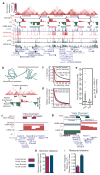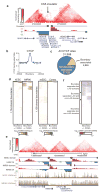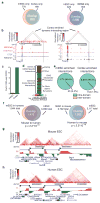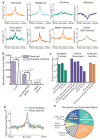Topological domains in mammalian genomes identified by analysis of chromatin interactions
- PMID: 22495300
- PMCID: PMC3356448
- DOI: 10.1038/nature11082
Topological domains in mammalian genomes identified by analysis of chromatin interactions
Abstract
The spatial organization of the genome is intimately linked to its biological function, yet our understanding of higher order genomic structure is coarse, fragmented and incomplete. In the nucleus of eukaryotic cells, interphase chromosomes occupy distinct chromosome territories, and numerous models have been proposed for how chromosomes fold within chromosome territories. These models, however, provide only few mechanistic details about the relationship between higher order chromatin structure and genome function. Recent advances in genomic technologies have led to rapid advances in the study of three-dimensional genome organization. In particular, Hi-C has been introduced as a method for identifying higher order chromatin interactions genome wide. Here we investigate the three-dimensional organization of the human and mouse genomes in embryonic stem cells and terminally differentiated cell types at unprecedented resolution. We identify large, megabase-sized local chromatin interaction domains, which we term 'topological domains', as a pervasive structural feature of the genome organization. These domains correlate with regions of the genome that constrain the spread of heterochromatin. The domains are stable across different cell types and highly conserved across species, indicating that topological domains are an inherent property of mammalian genomes. Finally, we find that the boundaries of topological domains are enriched for the insulator binding protein CTCF, housekeeping genes, transfer RNAs and short interspersed element (SINE) retrotransposons, indicating that these factors may have a role in establishing the topological domain structure of the genome.
Conflict of interest statement
The authors declare no competing financial interests.
Figures




Similar articles
-
Comparative Hi-C reveals that CTCF underlies evolution of chromosomal domain architecture.Cell Rep. 2015 Mar 3;10(8):1297-309. doi: 10.1016/j.celrep.2015.02.004. Epub 2015 Feb 26. Cell Rep. 2015. PMID: 25732821 Free PMC article.
-
Topologically associating domains are stable units of replication-timing regulation.Nature. 2014 Nov 20;515(7527):402-5. doi: 10.1038/nature13986. Nature. 2014. PMID: 25409831 Free PMC article.
-
Insulator function and topological domain border strength scale with architectural protein occupancy.Genome Biol. 2014 Jun 30;15(6):R82. doi: 10.1186/gb-2014-15-5-r82. Genome Biol. 2014. PMID: 24981874 Free PMC article.
-
Chromatin Domains: The Unit of Chromosome Organization.Mol Cell. 2016 Jun 2;62(5):668-80. doi: 10.1016/j.molcel.2016.05.018. Mol Cell. 2016. PMID: 27259200 Free PMC article. Review.
-
Genome-wide studies of CCCTC-binding factor (CTCF) and cohesin provide insight into chromatin structure and regulation.J Biol Chem. 2012 Sep 7;287(37):30906-13. doi: 10.1074/jbc.R111.324962. Epub 2012 Sep 5. J Biol Chem. 2012. PMID: 22952237 Free PMC article. Review.
Cited by
-
3D reconstruction of genomic regions from sparse interaction data.NAR Genom Bioinform. 2021 Mar 22;3(1):lqab017. doi: 10.1093/nargab/lqab017. eCollection 2021 Mar. NAR Genom Bioinform. 2021. PMID: 33778492 Free PMC article.
-
DNA methylation predicts age and provides insight into exceptional longevity of bats.Nat Commun. 2021 Mar 12;12(1):1615. doi: 10.1038/s41467-021-21900-2. Nat Commun. 2021. PMID: 33712580 Free PMC article.
-
A CRISPR Connection between Chromatin Topology and Genetic Disorders.Cell. 2015 May 21;161(5):955-957. doi: 10.1016/j.cell.2015.04.047. Cell. 2015. PMID: 26000472 Free PMC article.
-
Improving 3D Genome Reconstructions Using Orthologous and Functional Constraints.PLoS Comput Biol. 2015 May 22;11(5):e1004298. doi: 10.1371/journal.pcbi.1004298. eCollection 2015 May. PLoS Comput Biol. 2015. PMID: 26000633 Free PMC article.
-
Widespread rearrangement of 3D chromatin organization underlies polycomb-mediated stress-induced silencing.Mol Cell. 2015 Apr 16;58(2):216-31. doi: 10.1016/j.molcel.2015.02.023. Epub 2015 Mar 26. Mol Cell. 2015. PMID: 25818644 Free PMC article.
References
-
- Yaffe E, Tanay A. Probabilistic modeling of Hi-C contact maps eliminates systematic biases to characterize global chromosomal architecture. Nat Genet. 43:1059–65. - PubMed
Publication types
MeSH terms
Substances
Associated data
- Actions
Grants and funding
LinkOut - more resources
Full Text Sources
Other Literature Sources
Molecular Biology Databases

